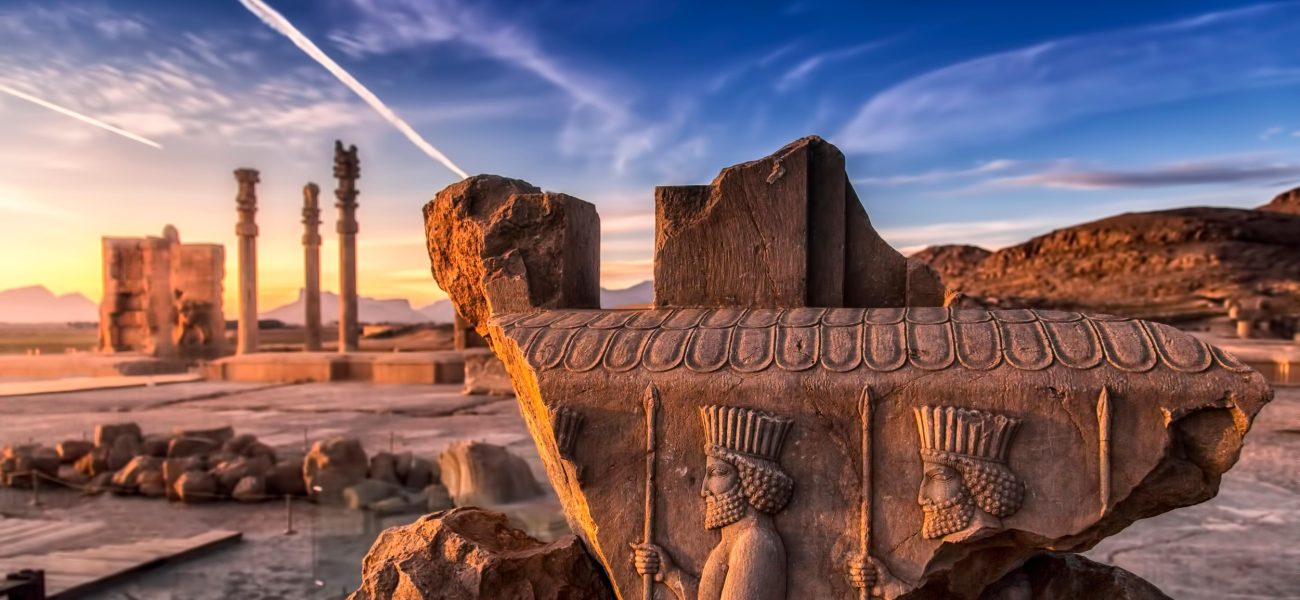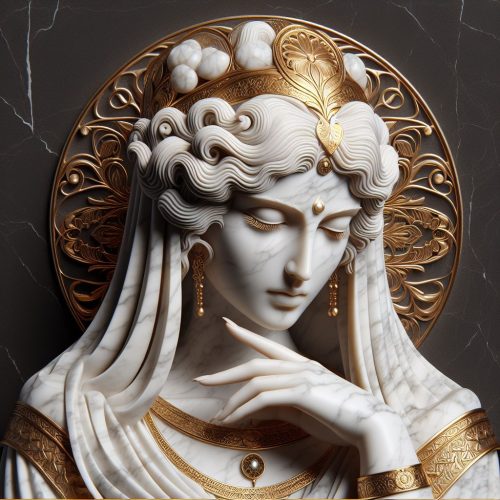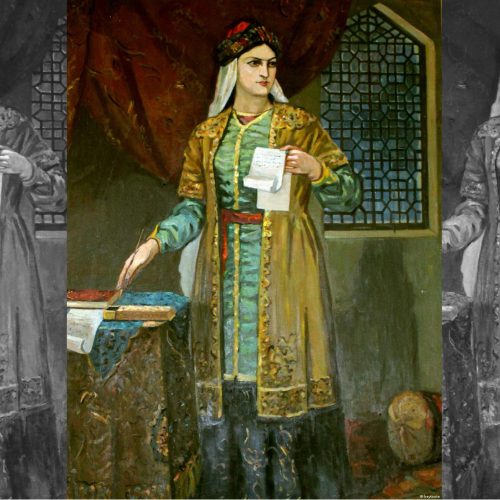By Dr. Dariush Mehrvand, Professor of Ancient Iranian Studies, University of Shiraz
The morning sun casts long shadows across the stone terraces of Takht-e Jamshid, as locals call it. I stand where kings once stood, feeling the same warmth on my face that touched Darius himself. This is Persepolis – “city of the Persians” – though we Iranians have always known it by another name. Every visit reminds me that beneath these stones lies not just archaeology, but our cultural memory.
The Names We Remember
The wind whispers different names as it passes through the remains of the ceremonial capital of the Achaemenid Empire. “Parsa” was its original Persian name – the city of the Parsis, the Persians. When Greek writers first encountered this magnificent city, they called it Persépolis (Περσέπολις), literally “Persian city,” a name that eventually spread throughout the Western world.
But we Iranians have long called it Takht-e Jamshid – “The Throne of Jamshid.” This name connects the ruins to our ancient mythology, to Jamshid, the legendary king of Pishdadian dynasty from the Shahnameh. According to these stories, Jamshid ruled during a golden age when Iran knew no suffering. Walking through these ruins, I often wonder if our ancestors created this connection to claim the Achaemenid glory for even older Iranian traditions.
As a child, my grandfather would take me here during Nowruz celebrations. “This,” he would say, pointing to the grand staircase, “is where our kings welcomed the world.” Even then, before my academic career began, I understood that names carry power. Whether Parsa, Persepolis, or Takht-e Jamshid, each name represents a different tradition claiming connection to this magnificent place.
A Land Between Mountains
To understand Persepolis, you must understand its position in the landscape. I’ve traveled extensively throughout Iran, but there’s something special about the Marv Dasht plain where Persepolis stands. The city rises from a natural terrace at the foot of Kuh-e Rahmat (Mountain of Mercy), once called Mount Mithra. This mountain embraces the complex from the east, creating a natural backdrop for the ceremonial city.
The first time I brought my daughter here, we climbed the mountain at dawn. Looking down on the ruins from above, she understood what took me years of study to comprehend – Darius chose this location deliberately, creating a stage for imperial power with the mountain as its backdrop.
The Fars province surrounding Persepolis has always been the heartland of Persian identity. Just 60 kilometers northeast lies Pasargadae, Cyrus the Great’s capital. About 70 kilometers southwest, you’ll find the Sassanian rock reliefs at Naqsh-e Rustam. This concentration of imperial sites is no accident. The region offers fertile plains surrounded by protective mountains, with access to trade routes connecting the Persian Gulf to the interior.
In summer, the heat here can be overwhelming. I remember conducting surveys during a particularly brutal August, when the limestone seemed to radiate fire. Yet even in this harsh environment, the ancient engineers created an oasis. Archaeological evidence reveals elaborate water management systems – qanat underground channels bringing water from the mountains, cisterns storing precious rainfall, and drainage systems preventing flood damage.
Standing on the terrace during a spring rain, watching water flow perfectly through 2,500-year-old drainage channels, I’m reminded that Persepolis represents not just artistic achievement, but engineering brilliance born from an intimate knowledge of this specific landscape.
A Story Written in Stone
Every stone in Persepolis tells a story. Construction began around 518 BCE under Darius I (Darius the Great), who envisioned a ceremonial capital representing the glory of the Persian Empire. The city wasn’t built for administrative functions – that role belonged to Susa – but rather as a symbolic center, particularly for celebrating Nowruz, the Persian New Year.
As a child, my history textbooks presented a simplified timeline: Persepolis was built, it flourished, Alexander burned it. The reality I discovered through decades of research reveals a more complex narrative. The construction of Persepolis wasn’t a single project but evolved across generations of Achaemenid kings.
Darius laid the foundations and built the Apadana (the grand audience hall), the Treasury, and much of the Grand Stairway. His son Xerxes I added the Gate of All Nations and his own palace. Later kings – Artaxerxes I, Artaxerxes II, and Artaxerxes III – continued expanding the complex until Alexander’s conquest in 330 BCE.
I remember guiding a group of visiting scholars through the site years ago. One asked why we should consider Persepolis important beyond its artistic value. I pointed to the Apadana reliefs showing delegates from 23 nations bearing gifts. “This,” I explained, “is one of history’s first visual representations of a multicultural empire acknowledging its diversity.”
Indeed, the Achaemenid Empire governed through a system of relative tolerance that respected local customs and religions. The reliefs at Persepolis don’t show subjugated peoples but rather participants in a shared imperial project. When I teach my students about ancient governance, I often note that this approach – allowing cultural autonomy while maintaining central authority – helped the Persians maintain the largest empire of its time.
The end came dramatically. In 330 BCE, Alexander of Macedon captured Persepolis after defeating Darius III. Ancient sources, primarily Greek, claim Alexander burned the complex in revenge for Xerxes’ destruction of Athens 150 years earlier. Some scholars suggest it was a calculated political statement, others blame a drunken revel. As an Iranian historian, I find these explanations unsatisfying. Archaeological evidence suggests a more complex scenario – some buildings show fire damage, others don’t. The destruction was likely more selective than total.
What’s certain is that Persepolis never recovered its former glory. After Alexander’s death, the site gradually lost importance under the Seleucid dynasty. By the Sassanian period (224-651 CE), Persepolis was already ancient ruins, though still recognized as an important heritage site. Sassanian kings carved rock reliefs nearby, claiming connection to the Achaemenid legacy.
Uncovering the Past
The modern discovery of Persepolis reveals as much about geopolitics as archaeology. European travelers documented the ruins as early as the 1600s, but scientific excavation didn’t begin until the 20th century. In 1931, the Oriental Institute of the University of Chicago obtained permission from Reza Shah Pahlavi to conduct excavations under Ernst Herzfeld and later Erich Schmidt.
As a young archaeology student in the 1980s, I pored over their extensive documentation. The photographs, particularly Schmidt’s aerial surveys, revealed Persepolis in its landscape context for the first time. However, these excavations also represented a complicated period in Iran’s relationship with Western powers.
The excavation agreement granted Americans exclusive rights to conduct archaeological research at Persepolis for 30 years. Under this arrangement, discovered artifacts were divided between Iran and the excavators, with many significant pieces leaving the country. This practice, common in early 20th century archaeology, now seems deeply problematic from our perspective of cultural heritage protection.
After the 1979 Revolution, Iranian archaeologists took complete control of research at Persepolis. I joined my first Iranian excavation team in 1985 under Dr. Ali Mousavi. Working under the guidance of Iranian experts, I gained a different perspective on the site – not just as a monument of architectural achievement, but as a living symbol of Iranian cultural identity.
Recent decades have seen technological innovations transforming our understanding. Ground-penetrating radar has revealed previously unknown structures outside the main terrace. Digital reconstruction allows visitors to visualize the original painted facades. Conservation science has developed new methods to protect the soft limestone from environmental damage.
Most exciting for me has been the ongoing work on the Persepolis Fortification Archive – thousands of clay tablets describing administrative functions of the empire. These texts, written primarily in Elamite but also Aramaic, Old Persian, Greek, and other languages, provide unprecedented insight into daily life, economic organization, and the multicultural nature of the Achaemenid administration.
What Remains
Walking through Persepolis today, visitors first encounter the monumental stairway leading to the Gate of All Nations. I’ve climbed these stairs hundreds of times, yet each ascent feels meaningful. The steps are intentionally shallow and wide – designed for a dignified, processional approach that forced visitors to move slowly and deliberately into the king’s presence.
Beyond the gate stands the Apadana, the great audience hall supported by 36 columns, each originally 20 meters tall. Only a few remain standing, but they’re sufficient to suggest the hall’s grandeur. The Apadana’s eastern stairway contains the famous procession reliefs showing delegates from across the empire bringing tribute.
I often linger at the Treasury, where thousands of tablets were discovered, and imagine the administrative activity that once filled these rooms. Nearby stands the unfinished gate, abandoned mid-construction when Alexander arrived – a poignant reminder of imperial ambitions interrupted.
The most personal spaces are the palaces – of Darius, Xerxes, and later kings. Here you find smaller-scale architecture with intimate courtyards and private quarters. I remember bringing my son here on his tenth birthday, watching him run his hand along the stone doorframes where Persian kings once walked. “This isn’t just history,” I told him. “This is your inheritance.”
What strikes most visitors is the remarkable preservation of stone reliefs. Animals both real and mythological adorn the walls – lions, bulls, griffins. Royal figures process with dignified formality. Perhaps most famous is the image of the king seated on his throne, supported by representatives of the empire’s diverse nations – a powerful visual metaphor for Persian imperial ideology.
However, what remains represents only a fraction of Persepolis’ original splendor. The buildings once featured brightly painted facades, wooden roofs, and gold decorations. Textile hangings softened the stone interiors. Gardens surrounded the complex, providing shade and beauty. Archaeological evidence suggests the complex was designed to impress through a carefully orchestrated experience – each space revealing new wonders as visitors progressed.
Persepolis in Modern Times
Persepolis continues to play a central role in Iranian national identity. In 1971, Mohammad Reza Shah Pahlavi organized elaborate ceremonies at Persepolis celebrating “2,500 years of Persian monarchy.” As a young boy, I remember the extensive coverage on television, the special stamps issued, and the sense that Iran was reclaiming its ancient glory on the world stage.
These celebrations proved controversial. While intended to position Iran as an ancient civilization worthy of international respect, many Iranians viewed the lavish displays as wasteful and disconnected from contemporary realities. The event became a symbol of the Shah’s disconnection from ordinary Iranians’ concerns.
After the 1979 Revolution, attitudes toward Persepolis became more complex. Some revolutionary figures initially viewed pre-Islamic monuments with suspicion. I remember genuine concerns among my archaeological colleagues about the site’s future. However, cultural heritage officials successfully argued for Persepolis’ importance as part of Iran’s national patrimony, regardless of its pre-Islamic origins.
Today, Persepolis receives hundreds of thousands of visitors annually, particularly during Nowruz celebrations. Iranians from across the country make pilgrimages to connect with their heritage. International tourism has fluctuated with geopolitical tensions, but the site’s UNESCO World Heritage status (granted in 1979) helps ensure its continued protection and international recognition.
Climate change presents new challenges for conservation. Increasing temperature fluctuations, unexpected rainfall patterns, and air pollution threaten the soft limestone. I’ve worked with conservation teams implementing new protective measures – from water drainage improvements to experimental protective coatings for particularly vulnerable reliefs.
Our Heritage Abroad
Walking through the Ancient Near East galleries of museums in London, Paris, Chicago, or Berlin reveals a disturbing truth – significant portions of Persepolis exist outside Iran. The British Museum displays stone reliefs and architectural fragments. The Louvre houses the magnificent capital of a column from the Apadana. The Oriental Institute Museum in Chicago exhibits numerous artifacts from their excavations.
These dispersed collections tell a complicated story of archaeological practice, imperial power, and cultural heritage. Many pieces left Iran legally under the partage system that divided findings between excavators and host countries – a practice now abandoned in favor of keeping archaeological materials in their countries of origin.
The most controversial case involves the Persepolis Fortification Archive – thousands of clay tablets discovered in the 1930s and loaned to the University of Chicago for study. Legal battles over these tablets have raged for decades, with Iran demanding their return and various parties attempting to claim them as compensation for political grievances. For scholars like myself, these disputes are heartbreaking – the tablets represent irreplaceable historical documents that should be studied for their cultural value, not leveraged for political purposes.
Visiting these collections abroad produces mixed emotions. During my doctoral research at the Oriental Institute, I had unprecedented access to Persepolis artifacts. The scientific value of this opportunity was immeasurable. Yet I couldn’t escape feeling these objects were displaced, separated from their context and the people whose heritage they represent.
Museums housing Persepolis collections have made varying efforts to acknowledge these complexities. Some have developed digital repatriation projects, creating 3D scans accessible to Iranian scholars. Others have organized traveling exhibitions bringing artifacts temporarily back to Iran. These efforts represent small steps toward recognizing that while legal ownership may rest with foreign institutions, the cultural ownership remains with the Iranian people.
The Stones Still Speak
As twilight descends over Persepolis, the limestone takes on a golden hue. Tourists depart, and silence returns to the ancient terraces. In these quiet moments, I often reflect on what these ruins mean to different people – to archaeologists seeking data, to nationalists seeking pride, to ordinary Iranians seeking connection with their past.
For me, after decades of study, Persepolis represents the possibility of cultural achievement through diversity. The Achaemenid Empire succeeded not by erasing differences but by creating systems where various traditions could coexist productively. The art of Persepolis – combining Egyptian, Mesopotamian, Greek, and Central Asian influences into something uniquely Persian – demonstrates the creative potential of cultural exchange.
Last year, I brought my grandson here for the first time. As we climbed the grand staircase, I asked what he saw. “Big old stones,” he said with childish honesty. By the end of our visit, after stories of ancient kings, explanations of the reliefs, and a picnic in the shadow of the Apadana, his perspective had changed. “It’s like our old house,” he declared, “but for everyone in Iran.”
Perhaps that’s the most accurate description I’ve heard. Persepolis belongs to all Iranians as a cultural inheritance, but it also belongs to humanity as a testament to what we can achieve. The stones still speak to those willing to listen, telling stories of ambition and achievement, of cultural synthesis and artistic brilliance, of imperial power and human creativity.
As the stars appear above the ruined columns, I gather my notes and prepare to leave. Tomorrow will bring new visitors, new questions, new interpretations. Persepolis has endured for 2,500 years, outlasting empires and ideologies. In a world of constant change, there’s profound comfort in that permanence.




